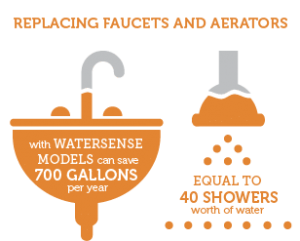 While many New Year’s resolutions include renewing that old gym membership or cleaning out the garage, a great way to start the new year off right is to focus on conserving water. With severe drought across the country, including New England, water is becoming ever more valuable and people are looking for ways to get the most out of every drop. One of the easiest steps we can take to help mitigate the impacts of drought is conserving water. Unlike most New Year’s resolutions, making a few simple changes to save water is an easy resolution to stick to and it makes a significant difference in the world. Let’s look at a few simple ways you and your community can conserve water.
While many New Year’s resolutions include renewing that old gym membership or cleaning out the garage, a great way to start the new year off right is to focus on conserving water. With severe drought across the country, including New England, water is becoming ever more valuable and people are looking for ways to get the most out of every drop. One of the easiest steps we can take to help mitigate the impacts of drought is conserving water. Unlike most New Year’s resolutions, making a few simple changes to save water is an easy resolution to stick to and it makes a significant difference in the world. Let’s look at a few simple ways you and your community can conserve water.
Ditch Those Old Appliances

The average person in the United States uses about 80-100 gallons of water each day. Of that amount, almost all of it comes from appliances such as washing machines, dishwashers, toilets, and faucets. Toilets alone account for approximately 27% of the water consumed in your home and many older toilets use up to seven gallons of water per flush. Installing a high-efficiency toilet that uses less than 2 gallons per flush can save up to 18,000 gallons of water a year – about $120 off your water bill annually. And if you really want to go green, and are brave to boot – consider one of these alternative toilets!
Washing machines offer another opportunity to save water year-round. Washing machines, on average, account for around 20% of a household’s water use, and switching to a high-efficiency washing machine can cut that water consumption in half. If one in ten American households were to install high-efficiency appliances, we would save 74 billion gallons of water per year as a nation. That’s an annual savings of about $1.5 billion dollars on utility bills. These appliances may have a higher upfront cost, but when you save 30-75 percent of your water bill each month, these investments quickly pay for themselves.

For a more affordable option, updating fixtures such as showerheads and faucets around the house can significantly reduce the amount of water you use. Conventional showerheads use as much as 10 gallons of water per minute. Modern showerheads use just 2-3 gallons per minute, which saves water and minimizes the stress on your water heater. Also, installing faucet aerators can help regulate water pressure to create varying flow rates to use less water depending on the task at hand, saving thousands of gallons annually. Updating your appliances and faucets is the most cost effective solution when it comes to saving water. Combined with simple lifestyle changes, these innovative technologies enable us to save significant amounts of water.
Small Leaks, Big Problems
Although it may look insignificant, a lightly dripping faucet can waste over 20 gallons of water per day. Toilet leaks are another major problem that often go undetected. To check if a toilet might be leaking, place a “toilet dye” tablet in the toilet tank and closely monitor the toilet bowl. If, without flushing, the water in the bowl changes color within half an hour, the toilet has a leak that needs to be repaired. Another way to determine if there is a water leak in your home is to read your house water meter before and after an extended period when no water is being used, like when the family is away on vacation. If the meter does not stay the same, then you have a leak somewhere in your home.
Manage the Meat

Our favorite steak or burger may taste great, but it takes a lot of water to reach the dinner plate. A pound of beef requires almost 2,500 gallons of water to produce. By avoiding beef for just one day a week, we can save thousands of gallons of water each year. In fact, we would save more water by not eating one pound of beef than we would by not showering for six months. We can save even more by cutting out other foods that require a lot of water to produce such as almonds (1,929 gal/lb.), chocolate (2,061 gal/lb.), pork (1630 gal/lb.), and butter (2,044 gal/lb.). When we do eat beef or other water intensive foods, we should choose pasture raised because grass is less likely to require irrigation compared to corn or soy used in the conventional method of raising livestock. Even cutting out that one extra cup of coffee each day can save hundreds of gallons of water. Being conscious of what we eat is not only good for our health, but also the environment.
To Wrap It Up
When it comes to daily water usage, even the smallest action to save water is significant to combat our country’s severe drought. Paying attention to how you and your family use water in your home will help you come up with the best ways in which your family can make simple changes that can have a big impact. For your New Year’s resolution, think of one thing each day that will save water – even small ideas can add up to big savings, for both our wallet and our planet.










 It is widely known that America’s infrastructure is in desperate need of repair, rehabilitation, and replacement, and that the
It is widely known that America’s infrastructure is in desperate need of repair, rehabilitation, and replacement, and that the 










 Clean Air Day is an opportunity to acknowledge how important air quality is to our health. Since 1963, December 17 has been a day to celebrate one of the first environmental laws in the United States – The Clean Air Act. Through collaboration, the EPA works with both state and local governments to ensure clean air for everyone. Among the biggest threats facing this campaign are volatile organic compounds (VOCs). Common in thousands of household products, VOCs are invisible to the naked eye and can have serious effects on human health.
Clean Air Day is an opportunity to acknowledge how important air quality is to our health. Since 1963, December 17 has been a day to celebrate one of the first environmental laws in the United States – The Clean Air Act. Through collaboration, the EPA works with both state and local governments to ensure clean air for everyone. Among the biggest threats facing this campaign are volatile organic compounds (VOCs). Common in thousands of household products, VOCs are invisible to the naked eye and can have serious effects on human health. The EPA provides many steps on how to avoid VOCs both indoors and outdoors. Simple and effective steps such as proper ventilation and reduced use of pesticides can greatly improve the quality of air inside your home or building. For potentially hazardous products such as varnishes or fuel, it is important to read all warning labels and practice safe storage and handling. The EPA also advises to keep minimum exposure to chemicals such as benzene and perchloroethylene, or “perc,” a chemical commonly used for dry cleaning. Currently, there is no federally enforceable standard set for VOCs in non-industrial settings such as a home or small business. To learn more about VOCs, including current guidelines or recommendations set by various organizations, visit
The EPA provides many steps on how to avoid VOCs both indoors and outdoors. Simple and effective steps such as proper ventilation and reduced use of pesticides can greatly improve the quality of air inside your home or building. For potentially hazardous products such as varnishes or fuel, it is important to read all warning labels and practice safe storage and handling. The EPA also advises to keep minimum exposure to chemicals such as benzene and perchloroethylene, or “perc,” a chemical commonly used for dry cleaning. Currently, there is no federally enforceable standard set for VOCs in non-industrial settings such as a home or small business. To learn more about VOCs, including current guidelines or recommendations set by various organizations, visit  To preserve and improve the health of all humans and other life on Earth, we must defend the planet’s air quality. The Clean Air Act has provided the basis for an effective means of limiting dangerous air pollutants for the last half century. This Act and its enforcement by the EPA has undoubtedly saved the lives of hundreds of thousands of people and continues to set new standards for air quality management. Many western European nations have enacted similar legislation, which is a big step in the right direction for clean air!
To preserve and improve the health of all humans and other life on Earth, we must defend the planet’s air quality. The Clean Air Act has provided the basis for an effective means of limiting dangerous air pollutants for the last half century. This Act and its enforcement by the EPA has undoubtedly saved the lives of hundreds of thousands of people and continues to set new standards for air quality management. Many western European nations have enacted similar legislation, which is a big step in the right direction for clean air! On December 15, 2016, the New England Water Works Association (NEWWA) presented Tata & Howard Senior Vice President and Co-Founder Paul B. Howard, P.E., with the NEWWA State Leadership Award for the State of Massachusetts. The award recognizes outstanding leadership and contributions to the advancement of excellence in the water works profession. A past president of the Massachusetts Water Works Association (MWWA), Paul has over 38 years of engineering experience, all of which have been exclusively in the water environment. Throughout his career, Paul has been actively involved in state and regional water associations and has been a champion for the advancement of the water industry. All of us at T&H wish to extend our heartfelt congratulations to Paul on this well-deserved award!
On December 15, 2016, the New England Water Works Association (NEWWA) presented Tata & Howard Senior Vice President and Co-Founder Paul B. Howard, P.E., with the NEWWA State Leadership Award for the State of Massachusetts. The award recognizes outstanding leadership and contributions to the advancement of excellence in the water works profession. A past president of the Massachusetts Water Works Association (MWWA), Paul has over 38 years of engineering experience, all of which have been exclusively in the water environment. Throughout his career, Paul has been actively involved in state and regional water associations and has been a champion for the advancement of the water industry. All of us at T&H wish to extend our heartfelt congratulations to Paul on this well-deserved award! Water systems today face a set of problems that are unique to this generation. While our nation’s buried infrastructure is crumbling beneath our feet as it reaches the end of its useful life, supplies are dwindling, budgets are shrinking, and federal and state funding is drying up. At the same time, regulatory requirements continue to increase as emerging contaminants are identified. Water systems often find themselves in the quandary of whether to upgrade treatment systems to comply with these new regulations or update assets that are long overdue for replacement or rehabilitation.
Water systems today face a set of problems that are unique to this generation. While our nation’s buried infrastructure is crumbling beneath our feet as it reaches the end of its useful life, supplies are dwindling, budgets are shrinking, and federal and state funding is drying up. At the same time, regulatory requirements continue to increase as emerging contaminants are identified. Water systems often find themselves in the quandary of whether to upgrade treatment systems to comply with these new regulations or update assets that are long overdue for replacement or rehabilitation. In addition to addressing capital efficiency, water utilities of today must also address operational efficiency. Because water systems are required to do so much with so little, efficiency in all aspects of water system management is critical. Tata & Howard appreciates the unique set of challenges faced by water systems today, and we have experts on staff who understand the inner workings of a water utility – and how to improve them.
In addition to addressing capital efficiency, water utilities of today must also address operational efficiency. Because water systems are required to do so much with so little, efficiency in all aspects of water system management is critical. Tata & Howard appreciates the unique set of challenges faced by water systems today, and we have experts on staff who understand the inner workings of a water utility – and how to improve them. Besides improving operational and capital efficiency, water systems of today must reduce non-revenue water. Non-revenue water is treated drinking water that has been pumped but is lost before it ever reaches the customer, either through real losses such as leaks, or through apparent losses such as theft or metering issues. In the United States, water utilities lose about 20% of their supply to non-revenue water. Non-revenue water not only affects the financial health of water systems, but also contributes to our nation’s decreasing water supply. In fact, the amount of water “lost” over the course of a year is enough to supply the entire State of California for that same year. Therefore, the AWWA recommends that every water system conduct an annual water audit using M36: Water Audits and Loss Control methodology to accurately account for real and apparent losses.
Besides improving operational and capital efficiency, water systems of today must reduce non-revenue water. Non-revenue water is treated drinking water that has been pumped but is lost before it ever reaches the customer, either through real losses such as leaks, or through apparent losses such as theft or metering issues. In the United States, water utilities lose about 20% of their supply to non-revenue water. Non-revenue water not only affects the financial health of water systems, but also contributes to our nation’s decreasing water supply. In fact, the amount of water “lost” over the course of a year is enough to supply the entire State of California for that same year. Therefore, the AWWA recommends that every water system conduct an annual water audit using M36: Water Audits and Loss Control methodology to accurately account for real and apparent losses.